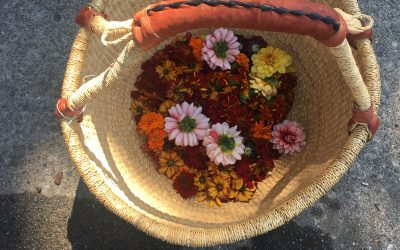Where do I, an eager-yet-amateur gardener, start my dye garden? During my first season, which plant can I depend on to survive as I learn through trial and error. Which one will grow in a small space and produce a high yield of dye pigment? Are there dye techniques that work only with fresh plants? Hapa zome and salt rub dyeing are fresh leaf dyeing methods that I can use with indigo. Thankfully, indigo is a weed that will endure mild neglect, provided it receives lots of water, and Japanese indigo (Persicaria tinctoria, also known as Polygonum tinctorium) has a hardiness suited to most of Canada’s biomes.
Eight weeks before the last frost, I fill a cheap plastic container (I use a kitty litter pan), 30 cm (12 inches) wide × 40 cm (16 inches) long × 10 cm (4 inches) deep, with 7.5 cm (3 inches) of potting soil. I use a chopstick to carefully poke pairs of Japanese indigo seeds 2.5 cm (one inch) down into damp potting soil, spacing the pairs 5 cm (2 inches) apart. The pan holds 48 pairs of seeds.


Once the seeds are safe in the soil, I water them to wash away abscisic acid (ABA). ABA is a plant growth hormone that keeps seeds dormant. When it is dissolved by water and washed away, mature seeds can begin to germinate and grow. In about a week, two delicate green leaves peek out, shyly growing upwards toward the light.
All photos by Magan Wilson.






